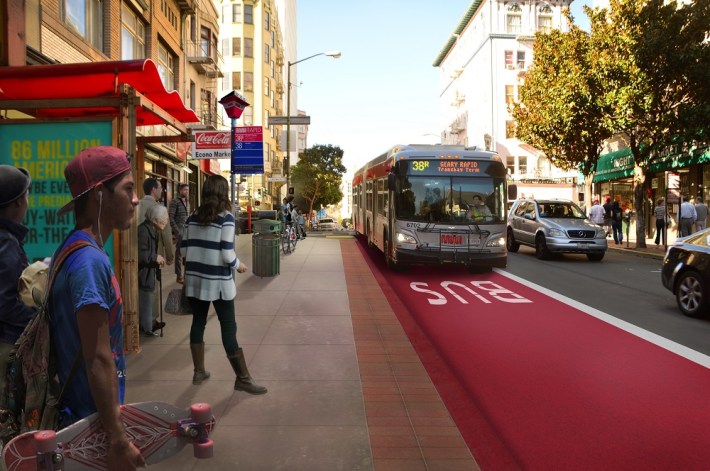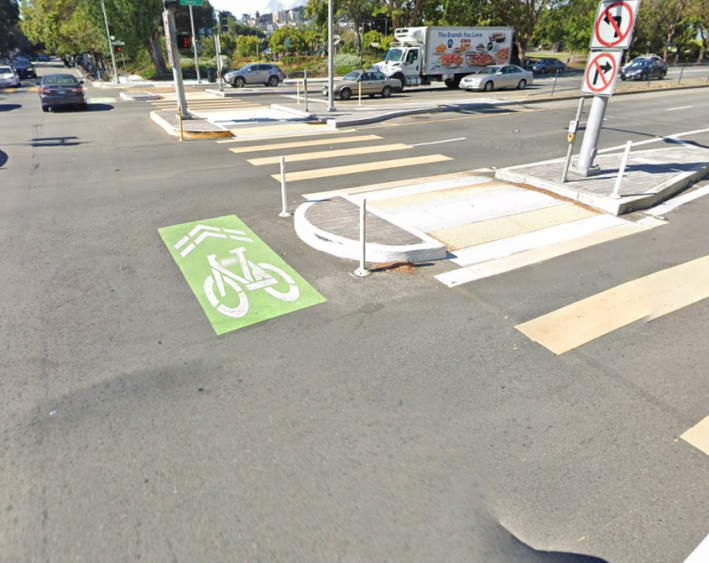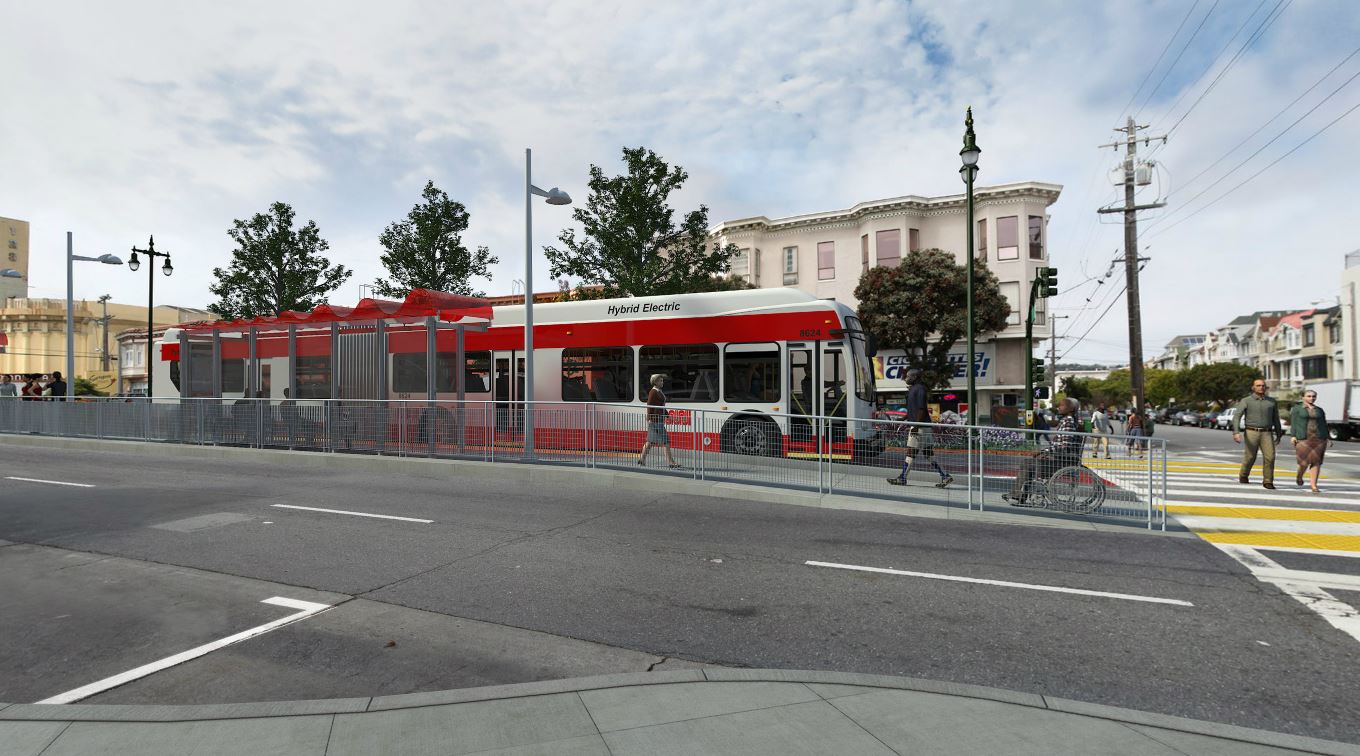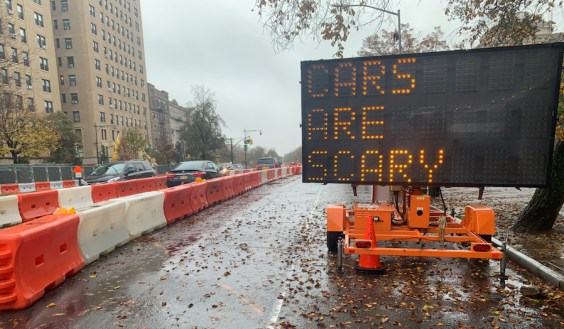Note: GJEL Accident Attorneys regularly sponsors coverage on Streetsblog San Francisco and Streetsblog California. Unless noted in the story, GJEL Accident Attorneys is not consulted for the content or editorial direction of the sponsored content.
After 21 years of discussing transit improvements for the 38-Geary, yesterday the SFMTA board approved another three miles of bus lane in the Richmond District. From the Chronicle:
Starting this fall, lanes reserved for Muni’s 38-Geary buses will extend from 32nd Avenue in the Richmond District to Market Street — realizing a concept that city planners first studied in 2002.
Pedestrian safety improvements, such as sidewalk extensions and median refuges, will also dot the Geary corridor, which is part of the high-injury network where most of San Francisco’s severe and fatal crashes happen.
Let's, however, not lose track of the fact that this was a giant bait-and-switch. See that nice lead image of a center-station for Geary BRT, much like what was accomplished on Van Ness? Well, Geary isn't getting that. It's getting more of this, from a rendering of the downtown section of the 38 "Rapid" project:

That's still an improvement for bus riders heading to and from the Richmond. But it leaves absolutely no room for cyclists. SFMTA blows this off, telling people to bike on Anza. That's not helpful if someone on a bike is trying to get to a destination on Geary, is it? SFMTA has to make every street safe for all users.

The pedestrian improvements are welcome, especially with Geary's high injury rate. And I don't mean to belittle the hard work of advocates with the San Francisco Transit Riders and other groups. But seriously--is some red paint in the slow lane really the best we can do after two decades?
First of all, enough with the debate over parking! Every merchant corridor in the Richmond was created by transit. Those shops only exist where they are in the first place because of San Francisco's historic streetcars (which, ironically, were faster than the 38 bus). Our friends at the Frisc and @VladSF summed this all up perfectly in this Tweet below:
Latching on to "the least we can do": Geary is exhibit A of taking the bar lower and lower. https://t.co/7AMPxZ6jIN
— The Frisc (@TheFrisc) August 15, 2023
Furthermore, SFMTA staff should see themselves as being in a race against time to save lives all over the city. Instead, they waste millions of dollars and many years redoing street experiments and doing pointless outreach, listening to a subset of merchants make the same easily falsifiable claims about the loss of some street parking and its supposedly detrimental effects on business.
I'm especially mad about this right now, because a little girl was run down and killed at 4th and King while Tuesday's debate over Geary dragged on at the SFMTA board. The girl, who was in the crosswalk, was hit by a driver making a turn. It was exactly the type of crash a Dutch-style protected intersection is designed to prevent.
In the time it took @SFMTA_Muni to approve the Geary Boulevard transit improvements, a 38 Geary bus could have driven to the moon and back (477,800 mile round trip) at the posted 35 MPH speed limit.
— Kane 謝凱堯 (@kane) August 16, 2023
Forget 21 years debating a single bus project. Governing bodies from Sacramento on down need to grab the CROW manual (the Dutch street design guide), and mandate cities to start following global best practices every time they repave. That means: center-running transit whenever ridership is above a certain level, side-running, concrete- or steel-protected bike lanes, protected intersections, pedestrian refuges, bollards - the works. The only time a city should deviate from international best practices is to build even larger-than-prescribed barriers and bollards to deal with America's obsession with giant, deadly automobiles.
And yeah, the state needs to be spending billions on high-capacity rail lines too, especially on Geary. That does not mean wasting money building subways in places where they make no sense. As the Dutch, Swiss, and many other countries have shown, you can have fast, reliable, and inexpensive high-capacity rail transit wholly or partially on the surface. You just need to stop giving cars total priority.
Does that seem far-fetched and idealistic? It always does, until leaders make change happen. But the Geary fight makes one thing clear: without a sea change in governance, the whole project to reduce street fatalities and make it safe to walk and bike and travel around San Francisco without a car is a lost cause.






